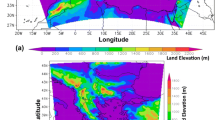Abstract
A procedure is proposed for calculating extreme characteristics of the level of a sea with allowance for positive and negative setups. Analysis is made of past storm events in the Northern Caspian Sea that have caused strong setups. Sixty-three storm weather patterns are chosen from a period of 45 years. Time ring synoptic maps are used to digitize the atmospheric pressure fields and calculate the field of its gradient and the wind near water surface. Based on these data, the sea level values and currents are calculated through two- and three-dimensional hydrodynamic models. A probabilistic model along with computer-aided data treatment procedures are used to calculate the fields of extreme characteristics of the sea level at the Lagan gage with the occurrence of once per N years at the average Caspian Sea level of 27 m below SL.
Similar content being viewed by others
REFERENCES
Arkhipov, B.V. and Popov, S.K., Okeanologiya (Moscow), 1996, vol. 36, no. 6, p. 805.
German, V.Kh., Tr. Gos. Okeanogr. Inst., 1971, no. 107, p. 1.
German, V.Kh. and Levikov, S.P., Veroyatnostnyi analiz i modelirovanie kolebanii urovnya morya (Probabilistic Analysis and Simulation of Sea Level Fluctuations), Leningrad: Gidrometeoizdat, 1988.
Gidrometeorologiya i gidrokhimiya morei (Hydrometeorology and Hydrochemistry of Seas), St. Petersburg: Gidrometeoizdat, 1992, vol. 6, no. 1.
Gumbel, E.J., Statistics of Extremes, New York: Columbia Univ. Press, 1958. Translated under the title Statistika ekstremal'nykh znachenii, Moscow: Mir, 1965.
Makova, V.I., Tr. Gos. Okeanogr. Inst., 1989, no. 185, p. 23.
Mirzoev, D.A., Zil'bershtein, O.I., Lopatukhin, L.I., et al., Abstracts of Papers, Trudy IV Mezhdunarodnoi konferentsii “Osvoenie shel'fa Arkticheskikh morei Rossii” (RAO-99) (Proc. IV Int. Conf. “Development of Arctic Russia's Sea Shelf), St. Petersburg, 1999, p. 311.
Sarkisyan, A.S., Demin, Yu.L., Brekhovskikh, A.L., et al., Metody i rezul'taty rascheta tsirkulyatsii vod Mirovogo okeana (Methods and Estimation Results of World Ocean Water Circulation), Leningrad: Gidrometeoizdat, 1986.
Bachaus, J.O. and Hainbucher, D., Three-Dimensional Models of Marine and Estuarine Dynamics, Nihoul, J.C.J. and Jamart, B.M., Eds., Amsterdam: Elsevier, 1987, p. 221.
Bowden, K.F. and Hamilton, P., Estuarine Coastal Mar. Sci., 1975, vol. 3, p. 281.
Fang G.H. and Ichiye, T., Geophys. J. R. Astron. Soc., 1983, vol. 73, p. 65.
Flather, R.A. and Heaps, N.S., Geophys. J. R. Astron. Soc., 1975, vol. 42, p. 489.
Jenkinson, A.F., Q. J. R. Meteorol. Soc., 1955, vol. 87, p. 158.
Langbein, W.B., Trans. Am. Geophys. Union, 1949, vol. 30, no. 6, p. 879.
Oey, L.Y., Mellor, G.L., and Hires, R.I., J. Phys. Oceanogr., 1985, vol. 15, no. 11, p. 1676.
Ryabinin, V.E. and Zilberstein, O.I., Report no. 33, WMO/TD-N 799, Geneva: WMO, 1996, p. 1.
Author information
Authors and Affiliations
Rights and permissions
About this article
Cite this article
Zil'bershtein, O.I., Popov, S.K., Chumakov, M.M. et al. A Procedure for Calculating Extreme Characteristics of the Northern Caspian Sea Level. Water Resources 28, 632–639 (2001). https://doi.org/10.1023/A:1012833712510
Issue Date:
DOI: https://doi.org/10.1023/A:1012833712510




